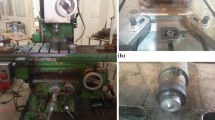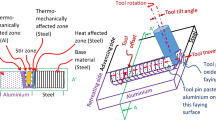Abstract
Friction stir welding (FSW) is a solid-state joining process, which has prominent advantages over common fusion welding methods like MIG welding. However, equipment costs and royalties act as the main barriers to the widespread use of this technique in today’s industry. Thus, developing low-cost FSW techniques could pave the way for potential industrial users. In this research, we are going to characterize and optimize a recently developed FSW technique at right angle (RAFSW) using low-cost three-axis CNC machine tools. To this end, a full study was done to gain a deep insight through the effect of RAFSW process parameters on generated axial forces and tensile properties of AA6061-T6 butt-welded flat bars of 6.35 mm thick. Experiment planning and modeling of the results used Taguchi design of experiments method and artificial neural network modeling respectively. From these models, an efficient working window of process parameters has been established so that CNC machines with minimized capacity and stiffness can produce high-quality welds repeatedly. After natural aging, the ultimate tensile strength reached a maximum of 253 MPa and stays above 247 MPa within the working window. Moreover, the robustness of the technique and the effect of artificial aging on the strongest samples have been evaluated. We found that the ultimate tensile strength of artificially aged samples attained 300 MPa. Finally, microstructure images and micro-hardness measurements of the strongest welded samples complete the analysis. The outcomes of this research have a great impact on making the recently proposed RAFSW technique reliable for industrial users.
Similar content being viewed by others
References
Mishra RS, Ma ZY (2005) Friction stir welding and processing. Mater Sci Eng R 50:1–78
Mathers G (2002) The welding of aluminium and its alloys. Woodhead Publishing Ltd, Abington Hall, Abington
Mishra RS, Mahoney MW (2007) Future outlook for friction stir welding and processing. In: Mishra RS, Mahoney MW (eds) Friction stir welding and processing. ASM International, Materials Park, pp 351–352 Number of 351–2 pp
Arbegast WJ (2007) Application of friction stir welding and related technologies. In: Mishra RS, Mahoney MW (eds) Friction stir welding and processing. ASM International, Materials Park, pp 273–308 Number of 273–308 pp
Nandan R, Debroy T, Bhadeshia H (2008) Recent advances in friction-stir welding – process, weldment structure and properties. Prog Mater Sci 53:980–1023
Gibson BT, Lammlein DH, Prater TJ, Longhurst WR, Cox CD et al (2014) Friction stir welding: process, automation, and control. J Manuf Process 16:56–73
Smith CB (2007) Robots and machines for friction stir welding/processing. In: Mishra RS, Mahoney MW (eds) Friction stir welding and processing. ASM International, Materials Park, pp 219–233 Number of 219–33 pp
Melendez M, Tang W, Schmidt C, McClure JC, Nunes AC, Murr LE (2003) Tool forces developed during friction stir welding. NASA Technical Reports, Document No: 20030071631
Mehta K, Badheka V (2016) Experimental investigation of process parameters on defects generation in copper to AA6061-T651 friction stir welding. Int J Adv Mech Automob Eng 3:55–58
Kumar K, Kailas SV (2008) On the role of axial load and the effect of interface position on the tensile strength of a friction stir welded aluminium alloy. Mater Des 29:791–797
Rajakumar S, Muralidharan C, Balasubramanian V (2010) Establishing empirical relationships to predict grain size and tensile strength of friction stir welded AA 6061-T6 aluminium alloy joints. Trans Nonferrous Metals Soc China 20:1863–1872
Rajakumar S, Muralidharan C, Balasubramanian V (2011) Predicting tensile strength, hardness and corrosion rate of friction stir welded AA6061-T 6 aluminium alloy joints. Mater Des 32:2878–2890
Elatharasan G, Kumar V (2013) An experimental analysis and optimization of process parameter on friction stir welding of AA 6061-T6 aluminum alloy using RSM. Procedia Eng 64:1227–1234
Ramulu P, Narayanan R, Kailas S, Reddy J (2013) Internal defect and process parameter analysis during friction stir welding of Al 6061 sheets. Int J Adv Manuf Technol 65:1515–1528
Mehta K, Badheka V (2015) Influence of tool design and process parameters on dissimilar friction stir welding of copper to AA6061-T651 joints. Int J Adv Manuf Technol 80:2073–2082
Imani Y, Guillot M (2014) Axial force reduction in friction stir welding of AA6061-T6 at right angle. ASME International Mechanical Engineering Congress and Exposition. ASME, Canada
Imani Y (2015) Development of friction stir welding techniques for multi-axis machines. Laval University, Canada, Ph.D. thesis
Imani Y, Guillot M, Tremblay A (2014) Optimization of FSW tool design and operating parameters for butt welding of AA6061-T6 at right angle. International Congress of Canadian Society for Mechanical Engineering. CSME, Canada
Imani Y, Guillot M, Tremblay A (2014) Study and application of complex 3D friction stir welding of butt and lap joints using a 5-axis CNC machine tool. International Congress of Canadian Society for Mechanical Engineering. CSME, Canada
Imani Y, Guillot M (2014) Tolerating for joint fit-up issues using welding parameters in friction stir welding of AA6061-T6 at right angle. International Congress of Canadian Society for Mechanical Engineering. CSME, Canada
Gao L, Harada Y, Kumai S (2015) Microstructural characterization of aluminum alloys using Weck’s reagent, part I: applications. Mater Charact 107:426–433
Rao RV, SpringerLink (2011) Advanced modeling and optimization of manufacturing processes international research and development. Springer, London
Das B, Pal S, Bag S (2017) Torque based defect detection and weld quality modelling in friction stir welding process. J Manuf Process 27:8–17
Okuyucu H, Kurt A, Arcaklioglu E (2007) Artificial neural network application to the friction stir welding of aluminum plates. Mater Des 28(1):78–84
Tang W, Guo X, McClure J, Murr L (1998) Heat input and temperature distribution in friction stir welding. J Mater Process Manuf Sci 7:163–172
Kumar K, Kailas SV (2008) The role of friction stir welding tool on material flow and weld formation. Mater Sci Eng A 485:367–374
Cole E, Fehrenbacher A, Shultz E, Smith C, Ferrier N et al (2012) Stability of the friction stir welding process in presence of workpiece mating variations. Int J Adv Manuf Technol 63:583–593
Shultz EF, Cole EG, Smith CB, Zinn MR, Ferrier NJ, Pfefferkorn FE (2010) Effect of compliance and travel angle on friction stir welding with gaps. J Manuf Sci Eng 132:041010
Widener C, Tweedy B, Burford D (2006) Effect of fit-up tolerances on the strength of friction stir welds. 47th AIAA/ASME/ASCE/AHS/ASC Structures. Structural Dynamics, and Materials Conference Newport, Rhode Island
Takahara H, Motoyama Y, Tsujikawa M, Oki S, Chung SW, Higashi K (2007) Allowance of deviation and gap in butt joint on friction stir welding. Adv Mater Res 15–17:375–380
Author information
Authors and Affiliations
Corresponding author
Rights and permissions
About this article
Cite this article
Momeni, M., Guillot, M. Development of friction stir welding technique at right angle (RAFSW) applied on butt joint of AA6061-T6 aluminum alloy. Int J Adv Manuf Technol 99, 3077–3089 (2018). https://doi.org/10.1007/s00170-018-2672-8
Received:
Accepted:
Published:
Issue Date:
DOI: https://doi.org/10.1007/s00170-018-2672-8




